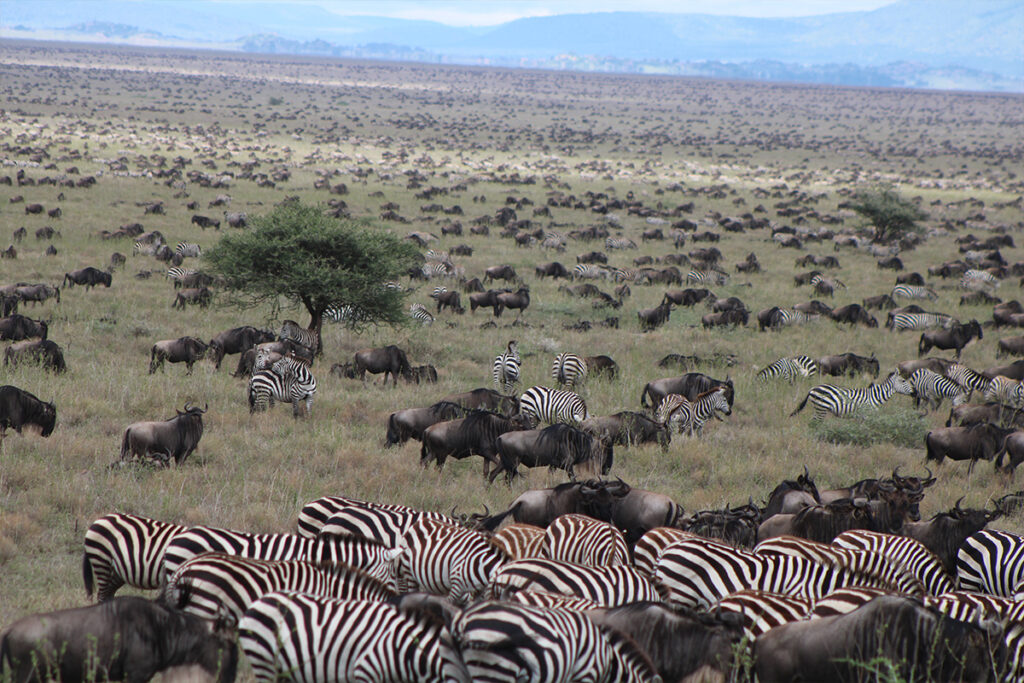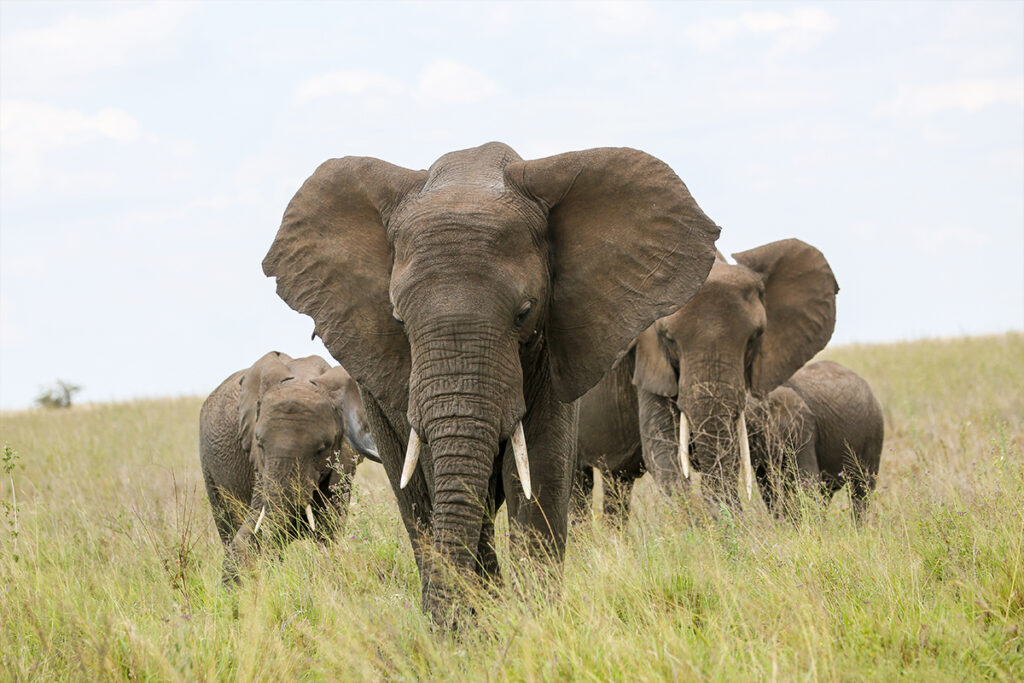Consider the fact that Kenya’s Maasai Mara boasts one of the highest densities of wildlife in the world. The Great Migration, where millions of wildebeest and zebras traverse from the Serengeti to the Mara, is a spectacle that attracts visitors universally. This awe-inspiring phenomenon alone gives Kenya a significant edge as an ideal safari destination.
However, Tanzania offers the largest concentration of wildlife out of any country, hosting roughly 20% of Africa’s mammalian population. With iconic destinations such as the Serengeti National Park and the Ngorongoro Crater, Tanzania is no lightweight contender. The diversity and expansiveness of its national parks and reserves ensure unparalleled safari experiences, catering to both seasoned experts and aspiring enthusiasts alike.

Wildlife Diversity in Kenya and Tanzania
Kenya is renowned for its rich wildlife, especially in the Maasai Mara. This iconic reserve hosts the Great Migration, where millions of wildebeest, zebras, and gazelles traverse the plains. Alongside these massive herds, you’ll find predators such as lions, cheetahs, and hyenas in abundance. Kenya’s diverse habitats range from savannahs to forested areas. This variety ensures an array of species for visitors to see.
Tanzania, on the other hand, boasts the Serengeti National Park, which rivals the Maasai Mara in offering mind-blowing wildlife experiences. The Serengeti is infamous for its vast plains and the incredible migration of animals it hosts. In addition to large mammals, Tanzania also supports smaller creatures. Visitors can spot everything from the tiny dik-dik antelope to the sleek serval cat. Birdwatchers will find an array of species as well.
Comparing both regions, you’ll find that each offers unique advantages. For instance, Kenya is known for its large elephant herds in places like Amboseli National Park. Tanzania is home to the Ngorongoro Crater, which provides a self-contained conservation area with diverse wildlife. Both destinations also feature coastal areas, where marine life adds another layer to the safari experience. Ultimately, both offer unforgettable wildlife excursions.
Furthermore, conservation efforts in both countries play significant roles. Organizations work tirelessly to protect endangered species and their habitats. Visitors can contribute to these efforts by choosing responsible tourism options. Apart from big animals, efforts are also made to protect endangered bird species. Thus, a safari in either Kenya or Tanzania supports wildlife preservation.
Exploring species variety and concentration in Maasai Mara and Serengeti
The Maasai Mara, located in Kenya, is teeming with wildlife and is famous for its high concentration of species. Visitors are likely to encounter lions, cheetahs, and leopards within a relatively small area. During the Great Migration, the Mara becomes alive with millions of wildebeest, zebras, and gazelles. The river crossings, full of crocodiles waiting for their prey, are a sight to behold. The diversity of the park ensures a fascinating safari experience year-round.
The Serengeti in Tanzania is equally impressive, with its vast plains and diverse animal populations. It’s home to more than 70 large mammal species and 500 bird species. The Serengeti’s wide-open landscapes provide ideal hunting grounds for large predators like lions and hyenas. The park also hosts the Great Migration, sharing this incredible event with the Maasai Mara. Every year, millions of animals move in search of greener pastures, creating a dynamic and ever-changing environment.
Both parks are renowned for their predator and prey dynamics. For instance, in the Maasai Mara, you’ll find large prides of lions, many of which are subjects of various documentaries. The Serengeti also hosts significant populations of cheetahs and leopards, adding to the excitement of a safari. Large herbivores such as elephants and giraffes are found in both parks, contributing to the rich biodiversity. These elements create ideal scenarios for observing natural behaviors and interactions.
For bird enthusiasts, both regions offer a plethora of avian species. In the Maasai Mara, you can spot birds like secretary birds and lilac-breasted rollers. The Serengeti is no less impressive with its ostriches, crowned cranes, and Fischer’s lovebirds. Birdwatchers can spend hours observing and documenting the various species. This added layer enhances the safari experience, making each visit unique and educational.
Iconic Safari Experiences
Kenya and Tanzania both offer unique safari experiences that attract visitors from around the world. In Kenya, one cannot miss the world-renowned hot air balloon safaris over the Maasai Mara. This breath-taking aerial view allows you to observe wildlife from above as the sun rises over the savannah. The feeling of floating silently over the landscape while watching herds of animals below is unforgettable. It’s a serene way to take in the beauty of the park.
Tanzania, on the other hand, offers a different yet equally thrilling experience—the Ngorongoro Crater safari. This vast volcanic caldera is home to an incredibly dense population of wildlife, including the Big Five: lions, elephants, buffalos, leopards, and rhinoceros. The unique landscape of the crater provides a concentrated environment where animals and their behaviors can be observed up-close easily. It also features lush vegetation and a beautiful lake, making it a photographer’s dream. Exploring the crater feels like entering an ancient world.
Night safaris in these regions add another layer of excitement. In Kenya, certain private conservancies allow visitors to venture out after dark to see nocturnal animals. Spotlights are used to catch glimpses of animals like the elusive leopard or the active porcupine. These safaris offer a different perspective on the behaviors and patterns of wildlife. Tanzania also offers night safaris in selected reserves and parks, adding to the diversity of experiences available.
Walking safaris provide a more intimate way to experience the African wilderness. Led by expert guides, these safaris let visitors learn about the flora and fauna up-close. In Kenya, walking safaris in Laikipia offer a chance to track animals on foot. Similarly, Tanzania’s Selous Game Reserve provides robust walking safari experiences. These walks are both thrilling and educational, offering a unique way to connect with nature.
Conservation Efforts and Ecotourism Impact
In both Kenya and Tanzania, conservation efforts play a critical role in preserving wildlife and natural habitats. National parks and reserves implement strict regulations to protect endangered species and combat poaching. Funds generated from tourism are vital for these conservation projects. This results in a symbiotic relationship where wildlife protection boosts tourism, and tourism funds enhance conservation. Examples include the anti-poaching units in Kenya’s Tsavo National Park and Tanzania’s Serengeti.
Both countries have numerous community-based conservation projects that involve local communities. These projects educate locals about the importance of conservation and provide alternative livelihoods to reduce dependence on poaching. In Kenya, the Maasai Mara conservancies work closely with the Maasai people. Similarly, in Tanzania, the Serengeti Preservation Foundation collaborates with nearby communities. These initiatives create a sense of ownership and responsibility among residents.
Ecotourism has a substantial impact on conservation efforts. By choosing eco-friendly safaris, tourists directly contribute to the preservation of natural habitats and species. Many safari lodges and camps have adopted sustainable practices. They utilize solar power, recycle waste, and participate in tree planting initiatives. This approach not only protects the environment but also offers tourists a way to travel responsibly.
Visitor education is also a significant part of conservation. Tourists are often briefed about the fragile ecosystem and the need to observe wildlife respectfully. Guided tours include explanations about animal behaviors, threats, and conservation strategies. This education fosters a deeper appreciation and understanding of the natural world. It also helps in spreading awareness about the necessity of conservation even after tourists return home.
Moreover, technological advancements have bolstered conservation efforts. Drones and camera traps monitor wildlife movements and detect poachers. This real-time data enables rapid responses to potential threats. Mobile apps allow scientists and tourists to record wildlife sightings and report suspicious activities. This technology-driven approach enhances the efficiency and effectiveness of conservation initiatives.
Accessibility and Tourist Infrastructure
Kenya and Tanzania both offer well-developed tourist infrastructure, making safari adventures accessible to visitors from around the globe. Kenya’s primary entry point is Nairobi, which is serviced by Jomo Kenyatta International Airport. From there, domestic flights and well-maintained road networks provide easy access to major parks like the Maasai Mara. Luxury lodges, eco-friendly camps, and budget accommodations cater to various traveler preferences. This comprehensive setup ensures a smooth travel experience.
Tanzania features Kilimanjaro International Airport as a primary gateway for safari travelers. Arusha, known as Tanzania’s unofficial safari capital, connects visitors to major national parks such as Serengeti and Tarangire. Domestic flights are readily available, and road trips are part of the adventure. The country offers a range of accommodations from upscale lodges to tented camps. This variety accommodates diverse budgets and travel styles.
Both countries have also invested in enhancing their national parks’ facilities to improve accessibility. Visitor centers, well-marked trails, and viewing platforms are common features in major parks. These additions make wildlife viewing more enjoyable and informative. Additionally, efforts to provide wheelchair accessible options have been implemented in several locations. This inclusivity extends the safari experience to all, regardless of physical ability.
Communication and connectivity have also seen improvements. Most lodges and camps offer Wi-Fi, allowing tourists to stay connected. Guides and rangers are usually fluent in multiple languages. This helps in catering to international visitors’ needs more effectively. Translation services and multilingual materials are available in many parks.
Health and safety are other key areas of focus. Medical facilities are within reach of major parks, and many lodges have trained staff for emergencies. Tourists are briefed on safety protocols to ensure a secure experience. Vaccinations and travel insurance are recommended, providing an added layer of protection. This emphasis on health and safety reassures travelers, making the adventure more enjoyable.
Best Time to Visit for a Safari
Knowing the best time to visit Kenya and Tanzania can enhance your safari experience. In Kenya, the dry season from July to October is ideal for wildlife viewing, coinciding with the Great Migration in the Maasai Mara. This period offers perfect conditions as animals gather around water sources, making them easier to spot. The lush green landscapes after the rainy season also provide stunning backdrops for photography. However, excellent game viewing is still possible outside these months.
In Tanzania, the dry season, from June to October, is also prime time for safaris. The Serengeti’s Great Migration peaks between July and September when wildebeests cross the Mara River. Seeing these massive herds is both thrilling and unforgettable. Similarly, the Ngorongoro Crater remains accessible year-round, but the dry season provides the best visibility for animal watching. Availability of comfortable accommodations is usually higher during this season.
- January to February: A good time for calving season in the southern Serengeti.
- March to May: The rainy season sees fewer tourists and greener scenery.
- June to October: Prime dry season suitable for most parks and the Great Migration.
- November to December: Short rains can mean fewer crowds and more personal experiences.
The off-peak times, such as January to March, can offer unique advantages. During these months, the Serengeti sees the calving season, when thousands of wildebeest calves are born. This attracts predators and provides thrilling game drives. Although the landscape is greener and wetter, animal behavior can be more dynamic. Parks are less crowded during these periods, providing a more intimate experience with nature.
The weather is another crucial factor to consider. The dry season usually means sunny days and cooler nights, perfect for safaris. The rainy season, although less predictable, brings about dramatic thunderstorms that can be fascinating to watch. Adventurous travelers might enjoy the quieter parks and lush scenery during the rain. Depending on your preferences, both seasons offer unique and rewarding safari experiences.




